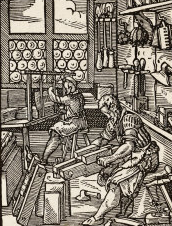Le Totem réinventé ou la transmission du Mythe par la littérature amérindienne
Keywords:
Totémisme, totem, amérindien, romanAbstract
La littérature amérindienne des trente dernières années illustre la possibilité d’une transmission culturelle dynamique et évolutive. Elle puise dans le mythe certains archétypes de l’identité indienne qu’elle se réapproprie pour mieux les revisiter et les réactualiser. David Treuer, Louise Erdrich et Sherman Alexie s’emparent du genre de la littérature de fiction pour réécrire à la fois leur histoire et leur quotidien et ainsi explorer la complexité de leur identité. Grâce à une écriture inventive qui tire les ficelles d’un réalisme magique empreint de traditions ancestrales, leurs romans proposent un renouvellement et un rajeunissement du mythe à travers un totémisme réinventé : le totem que nous présentent ces auteurs contemporains a ceci de particulier qu’il prend les traits d’une figure hybride à la fois esprit tutélaire des temps premiers et émanation de la société de consommation. Il se matérialise sous la forme d’un enfant métis handicapé dans Little, d’une voiture dans Love Medicine ou d’une guitare dans Reservation Blues. Ce faisant, à l’instar des légendes orales traditionnelles, l’écrit transmet à de nouvelles générations une version dépoussiérée du mythe et propose un nouveau lien entre l’individu et son groupe social, entre l’être et ses ancêtres. Au fil des métaphores et des symboles qui codifient les romans de ces nouveaux passeurs de culture, l’article étudie comment les figures totémiques mettent à l’épreuve les protagonistes, comment elles réinstaurent règles et interdits dans le chaos et dans quelles perspectives elles replacent une identité indienne contemporaine régénérée.
This article reviews three Native American novels searching for the transmission of a re-invented form of totemism. Contemporary Native American literature draws on myth and seizes specific archetypes of the Amerindian identity in order to revisit and update them. David Treuer, Louise Erdrich and Sherman Alexie use literary fiction to rewrite both their history and their daily life and thus explore their complex identity. They adopt a creative way of writing, marked by magical realism and ancient traditions, through which their novels propose a renewal and a rejuvenation of myth by means of re-invented totemism. The distinctive totem these authors present is a hybrid figure hiding a customary guardian spirit under the unusual features of the consumer society: it appears in the guise of a disabled mixed-race child in Little, of a car in Love Medicine and of a guitar in Reservation Blues. Their writing passes down a modernized version of myth to the next generation and offers a renewed bond between the individual and his social community, between the person and his ancestors. Going through the metaphors and symbols encoding the novels, this article first studies how totemic figures subject the protagonists to ordeal, then how they reestablish law and order upon chaos, and, finally, towards what perspectives they turn a regenerated contemporary Native American identity.
Published
Issue
Section
License
- Work submitted for publication must be original, previously unpublished, and not under consideration for publication elsewhere. If previously published figures, tables, or parts of text are to be included, the copyright-holder's permission must have been obtained prior to submission.
- Authors of accepted manuscripts will assign to L'Atelier the right to electronically distribute their article, or publish it in any form (Internet, CD ROM, printed copy) but authors will retain copyright and, after the article has appeared in L'Atelier, authors may republish their text (in print and/or electronic form) as long as they clearly acknowledge L'Atelier as the original publisher.


